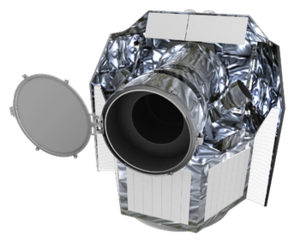
Back كيوبس Arabic CHEOPS BS CHEOPS Catalan CHEOPS (Weltraumteleskop) German CHEOPS (satélite) Spanish چیاپس Persian CHEOPS French Telescopio espacial CHEOPS Galician CHEOPS HE CHEOPS Hungarian
 An artist's impression of the CHEOPS space observatory | |
| Mission type | Exoplanetology, astrophysics |
|---|---|
| Operator | Swiss Space Office / ESA |
| COSPAR ID | 2019-092B |
| SATCAT no. | 44874 |
| Website | cheops sci |
| Mission duration | 3.5 years (nominal) + 3 years (extended)[1] Elapsed: 5 years, 1 month and 10 days (in progress) |
| Spacecraft properties | |
| Spacecraft type | Space observatory |
| Bus | SEOSAT[2] |
| Manufacturer | Airbus Defence and Space (Spain) |
| Launch mass | 273 kg [3] |
| Payload mass | 58 kg [4] |
| Dimensions | 1.5 × 1.5 × 1.5 m (4 ft 11 in × 4 ft 11 in × 4 ft 11 in) |
| Power | 64 watts [5] |
| Start of mission | |
| Launch date | 18 December 2019, 08:54:20 UTC[6] |
| Rocket | Soyuz-ST-A/Fregat-M (Soyuz VS23) [7][8] |
| Launch site | Centre Spatial Guyanais, ELS |
| Contractor | Arianespace |
| Orbital parameters | |
| Reference system | Geocentric orbit[9] |
| Regime | Sun-synchronous orbit |
| Perigee altitude | 712 km (442 mi) |
| Apogee altitude | 715 km (444 mi) |
| Inclination | 92.80° |
| Period | 90.00 minutes |
| Main telescope | |
| Type | Ritchey–Chrétien frame-transfer back-side illuminated CCD |
| Diameter | 32 cm [10] |
| Focal ratio | f/8 |
| Wavelengths | 330 to 1100 nm |
| Transponders | |
| Capacity | 1.2 Gbit/day downlink [11] |
| Instruments | |
| Photometer[12] | |
 CHEOPS mission patch | |
CHEOPS (CHaracterising ExOPlanets Satellite) is a European space telescope. Its objective is to determine the size of known extrasolar planets, which will allow the estimation of their mass, density, composition and their formation. Launched on 18 December 2019, it is the first Small-class mission in ESA's Cosmic Vision science programme.[13]
The small satellite features an optical Ritchey–Chrétien telescope with an aperture of 30 cm, mounted on a standard small satellite platform. It was placed into a Sun-synchronous orbit of about 700 km altitude.
- ^ "CHEOPS mission extended". Portal. 8 March 2023. Retrieved 16 April 2023.
- ^ CHEOPS, EO Portal Directory Accessed on 14 December 2019
- ^ "Press Kit VS-23 Launch (in French)" (PDF). Arianespace. Retrieved 22 November 2022.
- ^ "The CHEOPS Payload: a single telescope". CHEOPS website. Retrieved 3 December 2022.
- ^ "CHEOPS – Executive Summary". Retrieved 3 December 2022.
- ^ Cite error: The named reference
liftoffwas invoked but never defined (see the help page). - ^ Cite error: The named reference
July2014was invoked but never defined (see the help page). - ^ CHEOPS has arrived in Kourou 16 October 2019
- ^ "VS23 Launch Press Kit" (PDF). Arianespace. December 2019. Retrieved 3 December 2022.
- ^ "CHEOPS – Mission Status & Summary". Retrieved 3 December 2022.
- ^ Cite error: The named reference
unibe spacecraftwas invoked but never defined (see the help page). - ^ Cite error: The named reference
photometerwas invoked but never defined (see the help page). - ^ "Call for Media: Cheops launch to study exoplanets". www.esa.int. Retrieved 13 December 2019.